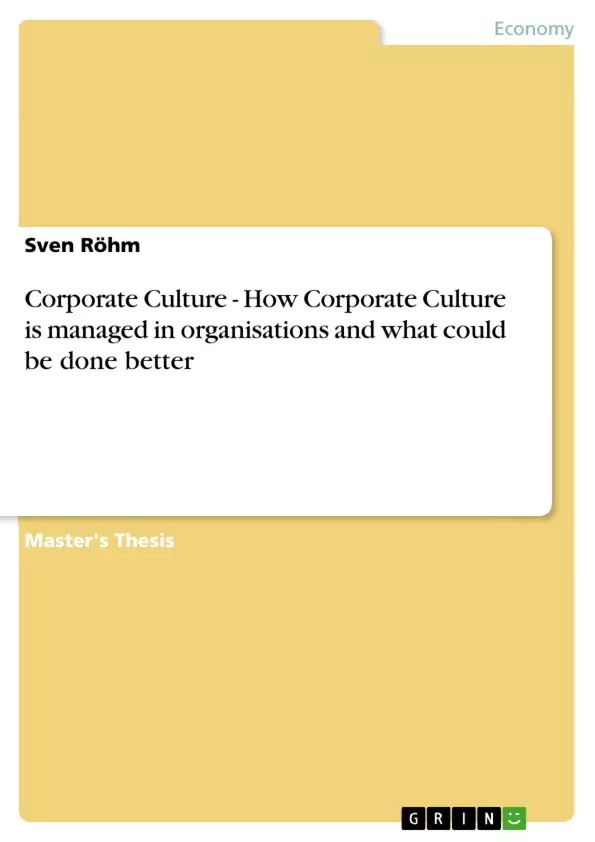Corporate culture has gained importance in the business world in the last two decades. The consideration of corporate culture, nevertheless, differs significantly in organisations. Some organisations have taken their corporate culture into account for strategic decisions (e.g. cultural fit during Mergers & Acquisitions) but other organisations have tended to neglect this issue at all.
Deal and Kenndy (1999) consider corporate culture as a hidden success factor of organisation which ensures commitment of the employees. According to them (1999), organisations with a ‘strong’ corporate culture outperform “run-of-the-mills companies by a massive margin”.
Corporate culture, nevertheless, has been a controversially discussed topic in the literature on which different general ‘best practices’ had been suggested by academics. However, it can be argued that the few empirical studies of corporate culture, notably Kotter and Heskett’s (1992) quantitative survey, have been methodologically limited (Alvesson, 2002), e.g. to few senior managers of the examined organisations. Therefore, this project employs, besides interviews with senior managers of the three examined German organisations, a survey which is focused on employees of different hierarchical and divisional levels in one organisation. The findings of the research clearly show that corporate culture is a far more heterogeneous phenomenon than many academics suggest.
In this research, corporate culture appears as a network of interrelating cultural patterns which is unique to different organisations due to different organisational and environmental challenges. The survey also identified that the perceptions of corporate culture differ between senior management and the employees. Therefore, the employees’ perception of the corporate culture must be taken into account in order to prevent cultural dichotomy. Furthermore, the senior management should implement a sustainable process of monitoring the development of corporate culture. Continuous monitoring enhances the understanding of the organisation and the consequences of managerial actions. Consequently, this can help to raise commitment and efficiency of the workforce.
Inhaltsverzeichnis (Table of Contents)
- Introduction
- What is Corporate Culture?
- Corporate Culture in Germany
- Managing Corporate Culture
- Heterogeneity of Corporate Culture
- Conclusion
Zielsetzung und Themenschwerpunkte (Objectives and Key Themes)
This research explores the management of corporate culture in German organizations, examining the challenges and opportunities associated with its heterogeneity. The primary objective is to provide insights into the complexities of corporate culture management within a specific national context.
- Definition and conceptualization of corporate culture
- Factors influencing corporate culture in German organizations
- Strategies for managing corporate culture heterogeneity
- Best practices and challenges in corporate culture management
- Implications for organizational performance and sustainability
Zusammenfassung der Kapitel (Chapter Summaries)
The first chapter introduces the concept of corporate culture and its significance for organizational success. It explores different definitions and models of corporate culture, providing a theoretical foundation for the subsequent analysis.
The second chapter examines the characteristics of corporate culture in Germany, highlighting key factors that influence its formation and development. It analyzes the impact of national culture, industry specifics, and organizational size on corporate culture.
The third chapter delves into the complexities of managing corporate culture, particularly within diverse and heterogeneous organizations. It explores different approaches to corporate culture management, including leadership styles, communication strategies, and employee engagement programs.
The fourth chapter examines the phenomenon of corporate culture heterogeneity, focusing on its potential benefits and challenges. It explores how to leverage diversity in corporate culture to enhance organizational performance and competitiveness.
Schlüsselwörter (Keywords)
The main keywords and focus topics of this work include: corporate culture, organizational culture, culture management, heterogeneity, diversity, Germany, organizational performance, leadership, communication, employee engagement, best practices, challenges, sustainability.
- Quote paper
- Sven Röhm (Author), 2004, Corporate Culture - How Corporate Culture is managed in organisations and what could be done better, Munich, GRIN Verlag, https://www.grin.com/document/52907



